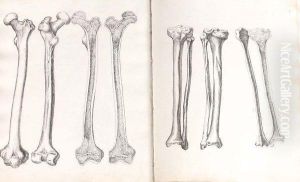Charles Frederic Nepveu Paintings
Charles Frederic Nepveu, born in 1793, was a Dutch painter, engraver, and lithographer, whose work and influence are nestled within the broader context of 19th-century European art. While not as widely recognized as some of his contemporaries, Nepveu's contributions to the art world during his lifetime were significant, particularly in the Netherlands, where he played a role in the artistic movements of his time. His career spanned a period of significant transition in European art, from the neoclassical traditions of the late 18th century to the burgeoning Romantic and realist movements that would define the 19th century.
Nepveu's oeuvre includes a variety of subjects, from landscapes and portraits to historical and mythological scenes, reflecting the eclectic tastes of the era. He was known for his meticulous attention to detail, a characteristic that endeared him to patrons and the art-buying public alike. His landscapes, often imbued with a romantic sensibility, capture the sublime beauty of the natural world, while his portraits are noted for their psychological depth and realism.
Despite his talent, Charles Frederic Nepveu's work has not achieved the same level of fame as some of his peers. This relative obscurity may be attributed to various factors, including the immense competition among artists during his lifetime and the changing tastes of art collectors and critics in the years following his death in 1862. Nevertheless, his contributions to Dutch art and the broader European art scene during the 19th century remain important. His works are preserved in several collections and museums, where they continue to be studied and appreciated for their beauty and historical value.
Today, scholars and art historians recognize Nepveu as part of the rich tapestry of 19th-century European art. His legacy, while perhaps not as prominent as that of other artists from his era, is a testament to the diversity and depth of talent that characterized this dynamic period in art history. Through his paintings, engravings, and lithographs, Charles Frederic Nepveu offers us a window into the aesthetic and cultural currents of his time, making his body of work a valuable resource for understanding the evolution of European art in the 19th century.
